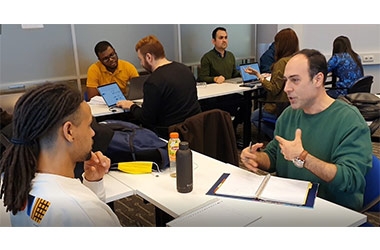Wittenborg Lecturer Develops Innovative Activity for Research Methods Classes
Wittenborg Lecturer Develops Innovative Activity for Research Methods Classes

Doron Zilbershtein’s Technique Based on Speed-Dating Principles
To help master’s students develop important academic skills, such as pitching ideas before an audience, collecting feedback and writing research proposals, Wittenborg senior lecturer Doron Zilbershtein has created an innovative teaching technique for his Research Methods classes.
Based on speed-dating principles, the method requires the class to be organised in two groups, A and B, sitting in two concentric circles facing each other. The inner circle is composed of group A students, who will have 30 seconds to present a research topic to their peers. Next, group B students will be given 90 seconds to provide group A students with feedback, and the latter should take detailed notes while listening to these comments.
Every two minutes, group A students will move in a counter-clockwise direction, to the seat on their left, while group B students will remain seated in the same place for the entire process until all students have been given feedback. Then, the participants switch places, with group B students taking the role of group A students and vice-versa.
After the end of the game, the lecturer gives additional feedback to the participants who would like to receive it. Later, as part of their homework, students are tasked with the development of their first research topic proposal, which they have one week to submit.
Zilbershtein explained that the activity is offered to MBM students
with the goal of addressing some of their most common difficulties,
including communicating their ideas in a concise way. “It can be very
challenging for students to adhere to the requirements of a thesis –
such as the word count of each section – and the speed-dating method is a
way for them to work on this. When you practise paying attention to
instructions, as well as to feedback, you will be able to take a closer
look at the details of the articles that you read, and you will learn
how to develop an argument while paying attention to contradicting
opinions,” he said.
According to Zilbershtein, lecturers should develop innovative methods
that make use of resources such as gamification in order to keep
students interested and motivated. “I am always looking for creative
ways to engage my students, because I do not want them to memorise
things, but rather to use their knowledge to create something new.”
MBM student Thi La, specialising in Digital Marketing & Communication, said that at first she was shy to participate in this activity, but as it progressed she felt more comfortable to share her ideas. “It turned out to be a fun and helpful activity, which gave me the chance to socialise with my classmates after a long time having online classes, and also provided me with lots of useful feedback on my research. It is really valuable to hear other perspectives apart from your lecturer’s,” she stressed.
Morgan Quintana, who is pursuing a degree in Sports Business Management, said that this exercise is a great way to open the participants’ minds by giving them access to input from the lecturer and other students. “I also enjoyed the concept of the fast interaction and the amount of information we were able to gather in such a short amount of time. I would say it has contributed to the development of my research proposal, the other students’ ideas and opinions being helpful towards my research and allowing me to identify potential gaps or setbacks,” he highlighted.
WUP 2/4/2022
by Ulisses Sawczuk
©WUAS Press
589 words